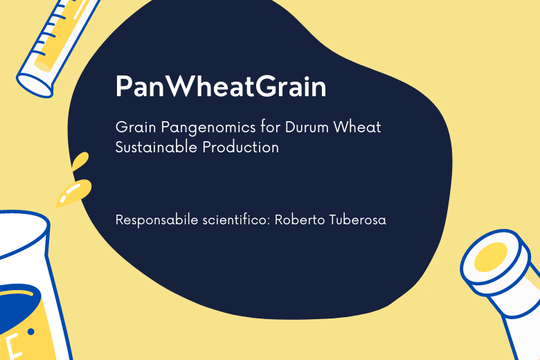Coordinator: Università di Bologna, DISTAL
Scientific Officer: Roberto Tuberosa
Duration: 08/05/2022 - 08/05/2025
Research group: Roberto Tuberosa, Marco Maccaferri, Elisabetta Frascaroli, Cristian Forestan, Fabrizio Ferrè
Ensuring global food security in view of climate change poses unprecedented challenges to wheat breeders, particularly in Mediterranean countries where both durum and bread wheat are consumed as staple. Italy and Mediterranean countries import large amounts of wheat, with the urgency to increase wheat production in a more sustainable fashion, hence using lower N-based fertilizers whose artificial production accounts for 70% of greenhouse gas (GHG) emission, the main cause of global warming. From an industrial and breeding standpoint, grain weight and proteins is the most valuable target trait and grain quality plays a pivotal role for nutritional value and health aspects.
The PanWheatGrain project will adopt a systemic approach to decipher the genetic and functional landscape under-pinning grain size and nutritional quality toward a more effective exploitation of native genetic variability in tetraploid wheat (Triticum turgidum spp.), the progenitor of the A and B genomes of hexaploid wheat. Tetraploid wheat collections available to project will allow to identify a core set of 10 accessions that capture a large variation of tetraploid wheat for gain size and quality. These 10 cultivars will be grown in controlled conditions under optimal and low nitrogen management, for: nitrogen use efficiency, grain protein and starch accumulation, grain protein deviation, yield.
The assembly of the tetraploid wheat pangenome will be based on golden-standard sequence of the diverse repre-sentative tetraploid wheat genotypes using PacBio HiFi long reads. 20 additional genomes will be sequenced at grain storage protein loci to characterize the structure, gene content, genetic diversity and functional regulation of storage protein genes in tetraploid wheats.
Transcriptomic and metabolomic (NMR) profiles of samples collected from the 10 pangenome accessions under opti-mal and sub-optimal N levels will allow us to define the biosynthetic/metabolic pathways and the gene regulatory networks relevant for grain protein and starch content, grain protein deviation, grain size. In addition, the functional role and associated allelic/functional diversity at will be investigated in an important defined targeted gene families/classes including gene families controlling nutrient availability and seed filling, seed size and transcription factors that integrate growth, N assimilation and C partitioning.
GWAS and meta-QTL analysis and haplotype-phenotype association will allow for the identification of the genomic regions relevant for the genetic control of the target traits and, through an integration of functional genomics and bioinformatics prediction, obtain clues on the possible causative variants. Sequencing of the 10 compo-nents of the pangenome will provide the basis for an omics-based functional atlas for grain morpho-physiological features. Based on this information, key regulatory effector targets will be targeted with gene editing to generate new allelic variants.

